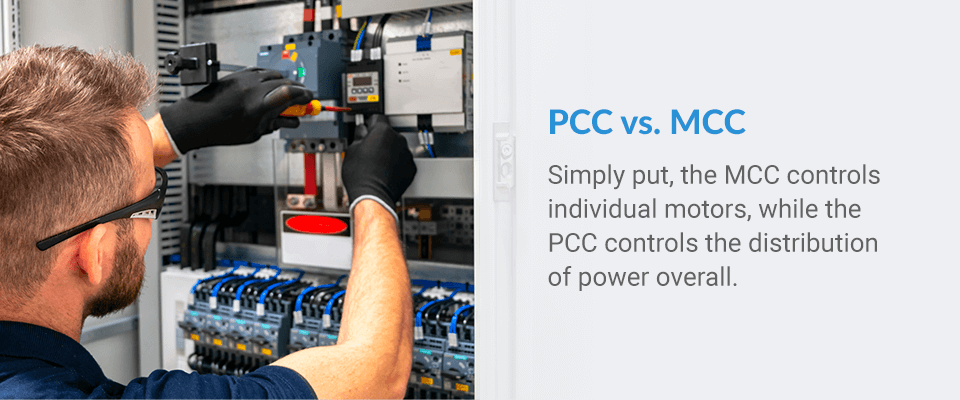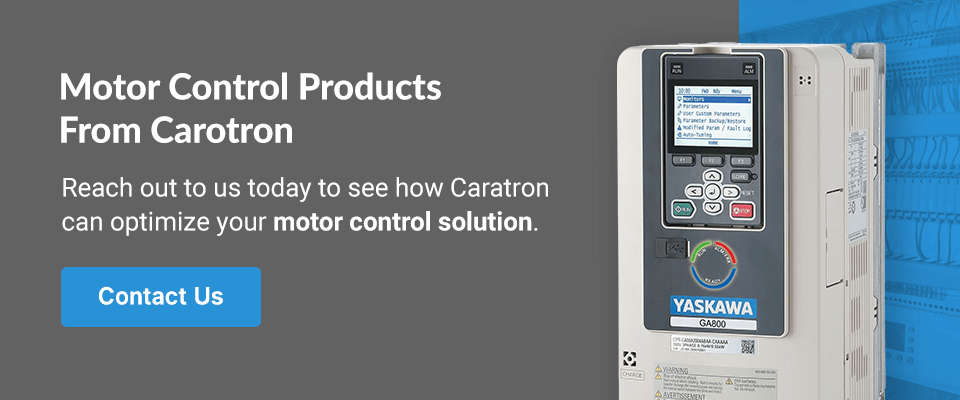FP605 Fan & Pump Drive Specifications
June 23, 2022AM-1000-XXX Series Specifications
February 27, 2023Motor Control Centers

Many industrial and commercial businesses use motor control centers (MCCs) to simplify motor management and protection. The purpose of a motor control center is to deliver comprehensive control from one centralized location. They're a valuable part of electrical distribution in large facilities.
Basics of Motor Control Centers
A motor control center is an assembly that controls multiple electrical motors from one location, usually an electrical or mechanical room. Because large power systems for commercial and industrial settings can be complex, the MCC provides control for the various elements involved in power distribution systems, such as switchboards, switchgear, panelboards and transformers. The MCC comprises enclosed sections that share a common power bus.
Each section has the following components:
- Contactor or solid-state motor controller
- Fuse or circuit breaker
- Disconnecting switch
The sections might also have features like push buttons, variable-frequency drives, metering equipment, indicator lights and programmable logic controllers (PLCs). The motors can power a range of applications across the facility, such as heating and cooling, lighting and machinery. In some areas, such as those that are hot or dusty, the MCC is housed in a separate, climate-controlled room.
An MCC has freestanding, enclosed structures that hold control units. A common bus bar brings power to the units, which are usually mounted in individual compartments. In many cases, these components create modules that can be removed without affecting the other modules.
You'll find motor control centers in nearly every field of business, from manufacturing and wastewater treatment to construction and the oil and gas industry.
MCC Voltage
MCCs are typically only used for low- to medium-voltage applications. Although the threshold can vary, low voltage usually refers to applications between about 200 volts and less than 1,000 volts. Medium voltage can be between about 2,300 volts to 15,000-25,000 volts. Beyond this threshold, you would need another solution like switchgear or power distribution center (PDC)
Switchgear vs. MCCs
Both switchgear and MCCs deliver power and can contain circuit breakers. Switchgear, however, is designed to distribute voltages to other pieces of equipment. It can handle higher voltages due to its ability to contain power issues in one cell. If an issue appears, switchgear can isolate it and prevent a larger shutdown. Then, the MCC — which sits downstream of the switchgear — can work to clear the fault while the switchgear contains it.

PCC vs. MCC
A power control center (PCC) is a broader panel that feeds into MCCs. If you have multiple MCCs, a PCC provides control over them. It works as a gateway for an electrical line. Simply put, the MCC controls individual motors, while the PCC controls the distribution of power overall. It could also feed into higher-voltage applications.
Types of MCCs
MCCs can come in different varieties. They often differ in how they approach the following factors.
1. Connectivity
An MCC could be traditional or “smart.” An intelligent MCC implements electronic protection mechanisms to replace conventional thermal overload devices. This smart protection comes from devices within the control unit, such as PLCs, circuit breakers and soft starters.
Some AC drives can even connect to a PLC inside the cabinet to transmit information over internal control networks. The AC motor control can communicate with other systems for more advanced functionality like monitoring, diagnostics and automation.
2. Starter
We can also organize MCCs by the kind of starter they use. Three starters you may see include:
- Direct on line starters: A direct on line (DOL) starter connects the motor directly to the line.
- Soft starters: A soft starter can gradually increase and decrease voltage as the MCC starts and stops.
- Variable speed AC drives: The most sophisticated option is a variable speed drive, or an AC drive, mentioned above. Along with greater connectivity, it offers the most control over speed and acceleration.
3. Module Design
An MCC might be fixed, semi-drawn or fully drawn out. These distinctions refer to how the components are divided. A fixed MCC has most components, like the contactor and circuit breaker, integrated into the frame. You can also find MCCs that partially draw out, so the system can still function if one module needs to be removed. Fully drawn-out models use drawers, so you can completely remove modules without affecting others.
4. Overcurrent Protection
An MCC might use fuses or circuit breakers to protect against overcurrents. A fuse offers one-time protection. The heat from an overcurrent melts an element in the fuse, breaking the line between the load and the source voltage. A circuit breaker is more advanced and allows you to quickly reactivate a circuit after it overloads or shorts. It offers a manual method of energizing and deenergizing for fast resets.
5. Arc Flash Protection
Some MCCs have arc flash protection mechanisms. Electrical arcs are highly dangerous and can cause injury, death, damage or fire. Many maintenance tasks require technicians to open the panel doors while working with the MCC.
Unfortunately, this is when many MCC arc flash incidents occur. For example, a technician might leave the panel door open while plugging in or removing a unit from a live bus, increasing arc flash risk.
Arc flash prevention mechanisms can allow technicians to safely open panel doors while keeping the system connected to power. These measures might include:
- Designs that allow units to be connected to and disconnected from the bus without opening the door.
- Isolation and insulation features.
- Designs that meet appropriate standards, like those from the National Fire Protection Association (NFPA).
- Safety interlocks that keep doors closed and lock units in place while stabs are connected to the bus.
- Clear labeling and status indicators.
6. Adherence to Standards
An MCC manufacturer might design according to one or more sets of standards from third-party organizations. Some of the most recognized standards come from the National Electrical Manufacturers Association (NEMA), ANSI and the International Electrotechnical Commission (IEC). These organizations develop standards that support transparency, safety and cost-effectiveness for various products. They may apply to manufacturers, distributors, installers, end users and others.
Look for an MCC that adheres to applicable standards. In some industries, you may need to meet standards for compliance.
Motor Control Products From Carotron
MCCs come in many styles, with a wide range of components and designs. Here at Carotron, we carry an array of quality MCC supplies, including AC drives, motor starters and power disconnects. With accuracy and reliability at the forefront of our business, our experienced engineering team is here to help you find, build or create the right product for your application.
Motor control is an essential part of business operations, and we can help you make sure it's done right. Reach out to us today to see how Caratron can optimize your motor control solution.

